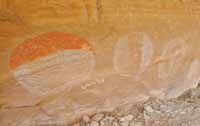| One action frequently resulting in damage to involves ‘chalking’ the panels.
|
The road from Carbon to Duchesne County often dominates the conversation when officials discuss Nine Mile Canyon. from Carbon to Duchesne County. Proposed changes, right of way issues and the dust emanating from the dirt byway are always of concern.
On Aug. 5, the Nine Mile Canyon Advisory Board met and one of the main topics of discussion was a change being considered near where Nine Mile and Dry Canyon roads join.
The project would realign the road to move it away from the Rasmussen Cave area and eliminate some other problems on the road.
The right of way for the road is retained by the county, but the land around the byway is owned by Bill Barrett Corporation, a company exploring and developing gas resources in the area. A proposed project would require joint cooperation between the two.
“I know that Barrett is interested in doing this project,” said company representative Don Hamilton. “But we need to wait until the new budget year to get started on it.”
The project would begin near the first of the year, added Hamilton.
The realignment of a road in the canyon is not without recent precedent. In summer 2004, BBC moved a section of road up Cottonwood Canyon away from the Great Hunt petroglyph panel, which many people felt was being damaged by the dust created by passing vehicles.
The realignment also created a walkway for people to view the panel without having to stand in the middle of what has become a busy road.
One complex issue involved with realignments involving private property and county rights of way or roads is the projects must be completed in a legal manner. Money is also an important factor.
“The new road alignment that has been discussed looks very expensive,” commented Rex Sacco, lands and access coordinator for Carbon County. “There may be some way to do it at a lower cost.”
The county recently did some geographical positioning system work in the area to determine exactly where the roads that exist lie in terms of the property in the area where the road changes could take place.
Hamilton suggested that BBC would like to avoid a stream crossing in the area and was thinking of using an existing path where a pipeline is located.
“However, I do know that the company wants to finish the Cottonwood Panel (Great Hunt) road realignment completely first,” noted Hamilton.
Floyd Johnson of the United States Bureau of Land Management suggested that the planning process for the proposed changes around the Rasmussen Cave should beginimmediately so the project will be ready to go next year.
“There’s a lot that can be done between now and December,” said Johnson. “But I know the county has to tie in the easement with the Rasmussen Cave route so it can legally expend dollars to help on the project.”
That discussion led to talk about projects in the canyon and how the improvements could be expedited.
“It has taken a lot of time to get the environmental assessments done on the signage we are ready to put in,” said Pam Miller of the College of Eastern Utah Prehistoric Museum. “There have been a lot of challenges. We must continue to work closely with the BLM on these kinds of projects.”
Johnson explained that the BLM is trying to get some of the projects cleared for approval all at once so, once the money is available, groups can go ahead with the plans.
Patrick Gubbins of the BLM explained that federal officials have been working to get a lot of approvals completed in time for Public Lands Day. The agency hopes to celebrate the event in the canyon on Sept. 18.
“The situation is such that we have to balance our decisions between many different factors,” he said. “For instance we want to try and get the work done on the Daddy Canyon trail this year, but there is a lot more work to do.”
Miller also brought up the fact that the public needs to be educated on rock art ethics.
“Recently, there was wonderful section in the Ogden Standard Examiner about Nine Mile Canyon,” she said. “But I was concerned about one of the photos that showed a little boy with his hand on some rock art. People need to learn not to touch the art. I think we need to come up with ways to educate the public that they shouldn’t do this type of thing.”
The committee looked at the section of the paper provided by Miller and discussed ways the members could let the public know what is proper and what isn’t.
The group also reviewed what has been happening at the Great Hunt panel and expressed hope that the site could be ready for a dedication on Public Lands Day. With the road nearly done and the landscape architect’s plan in place, it is going to take professional work on the viewing area by a rock mason and volunteer help to finish the area.
Carbon Commissioner Steve Burge noted that Barbara Paul from the Denver office of the National Trust for Historic Preservation in Colorado will be in the county on Aug. 19. The NTHP put Nine Mile Canyon on its list of the 11 most endangered historic sites in America. The move garnered significant national press attention.
Burge indicated that Paul would like to meet with the advisory board and the members agreed to do so.

